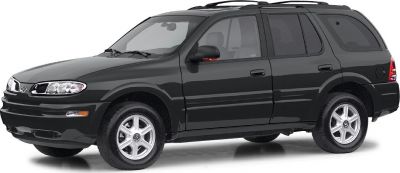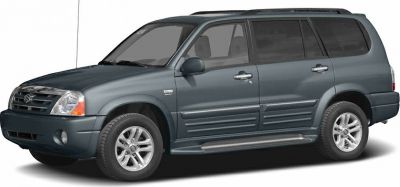 2002 Ford Explorer III Dimensions, Size & Specs
2002 Ford Explorer III Dimensions, Size & SpecsMeasurements of the 2002 Ford Explorer III, engineered for optimal performance and comfort
| Dimensions | |
|---|---|
| Length: | 4813 mm189.5 in15.8 ft |
| Width: | 1832 mm72.1 in6.0 ft |
| Height: | 1814-1830 mm71.4-72.0 in6.0-6.0 ft |
| Trunk Capacity: | 391-1320 liter13.8-46.6 cu ft |
| Trunk Capacity (Max): | 2490-2492 liter87.9-88.0 cu ft |
| Weight Specifications | |
| Curb Weight: | 1965-2065 kg4332-4553 lbs |
| Maximal permitted Weight: | 2595-2667 kg5721-5880 lbs |
| Tire Specifications | |
| Tire Sizes: |
|
The third generation Ford Explorer, produced from 2002 to 2005, is a midsize SUV known for its robust build and versatile interior space. Measuring between 4810 mm and 4813 mm (189.4 to 189.5 inches) in length, it offers a balanced footprint suited for both urban and off-road adventures. The width ranges from 1830 mm to 1832 mm (72.0 to 72.1 inches), while its height varies between 1814 mm and 1830 mm (71.4 to 72.0 inches), giving it a commanding presence on the road.
Curb weight for the Explorer III ranges from approximately 1965 kg to 2065 kg (4332 to 4553 lbs), depending on the configuration, with a maximum weight capacity between 2595 kg and 2667 kg (5722 to 5881 lbs). This weight class reflects the SUV’s strong construction and capability to handle a variety of driving conditions.
One of the key highlights of the Explorer III is its adaptable luggage capacity. With all seats in use, the cargo space ranges from 391 liters to 1320 liters (13.8 to 46.6 cubic feet), while folding down the rear seats dramatically increases luggage space to between 2490 liters and 2492 liters (87.9 to 88.0 cubic feet). This flexibility makes it ideal for families and those requiring extra room for gear or luggage.
Equipped with tire sizes of 245/70 R16 or 235/70 R16, the Ford Explorer III maintains good traction and stability across various terrains. Overall, the 2002-2005 Ford Explorer III combines practical dimensions and robust design to deliver a reliable and spacious SUV experience.
Discover the standout features that make the 2002 Ford Explorer III a leader in its class
Have a question? Please check our knowledgebase first.
The Ford Explorer III, produced from 2002 to 2005, measures approximately 4810 to 4813 mm (189.4 to 189.5 inches) in length, 1830 to 1832 mm (72.0 to 72.1 inches) in width, and 1814 to 1830 mm (71.4 to 72.0 inches) in height. These dimensions provide the Explorer III with a robust SUV presence, ample interior space for passengers, and a stable stance on the road. The slight variations in measurements correspond to different trims and optional equipment, which can affect the exact size slightly. This size classifies the Explorer III as a mid-to-large SUV, suitable for families and those needing cargo versatility.
The Ford Explorer III has a curb weight ranging from 1965 to 2065 kg (4333 to 4553 pounds), depending on the specific trim and equipment package. This is the weight of the vehicle with standard equipment, necessary fluids, and a full tank of fuel, but without passengers or cargo. The maximum weight, also known as gross vehicle weight rating (GVWR), ranges from 2595 to 2667 kg (5721 to 5881 pounds). This maximum weight includes passengers, cargo, and any additional accessories. The difference between curb weight and maximum weight informs the payload capacity and how much additional load the vehicle can safely carry.
The luggage capacity of the Ford Explorer III varies notably depending on rear seat configuration. With rear seats in their standard upright position, the cargo space ranges from 391 to 1320 liters (13.8 to 46.6 cubic feet), accommodating typical luggage or groceries for families. Folding down the rear seats expands this capacity dramatically to approximately 2490 to 2492 liters (87.9 to 88.0 cubic feet), allowing for large items such as furniture or extensive camping gear. This flexibility highlights the Explorer's utility for a range of needs, from daily use to recreational activities requiring more cargo space.
The Ford Explorer III has a height ranging between 1814 and 1830 mm (71.4 to 72.0 inches), a width of about 1830 to 1832 mm (72.0 to 72.1 inches), and length around 4810 to 4813 mm (189.4 to 189.5 inches). Most standard residential garages, especially single-car garages, have dimensions roughly 2400 mm (96 inches) wide, 2130 mm (84 inches) tall, and over 5000 mm (197 inches) deep. The Explorer III fits comfortably in terms of height and width, with some clearance to spare. Lengthwise, the Explorer III approaches the upper range of garage depths, meaning it will fit in most standard garages but might be a tight fit in smaller or unusually short garages. Careful measuring is recommended for confident clearance.
Compared to the Explorer II (1995-2001), the Ford Explorer III introduced subtle dimensional changes that affected overall space and styling. The Explorer III maintains a very similar length of about 4810 to 4813 mm compared to the Explorer II's length around 4726 mm, meaning it grew roughly 8 cm (around 3 inches) longer. Width increased slightly to approximately 1830-1832 mm, offering marginally more interior shoulder and cargo space. Height grew to up to 1830 mm compared to the predecessor, enhancing headroom and SUV presence. These dimension upgrades translated into improved passenger comfort and cargo versatility, while keeping driving dynamics familiar. In essence, the Explorer III built upon its predecessor by expanding interior and exterior space thoughtfully rather than radically changing its footprint.
During the early 2000s, the Ford Explorer III competes dimensionally with mid-size SUVs like the Jeep Grand Cherokee, Toyota 4Runner, and Chevrolet TrailBlazer. At around 4810 mm (189.4 inches) long and 1830 mm (72.0 inches) wide, the Explorer III is slightly longer and wider than the Toyota 4Runner of that era, which measured roughly 4630 mm (182 inches) long and 1810 mm (71.3 inches) wide. It's comparable in size to the Jeep Grand Cherokee, which measured about 4715 mm (185.6 inches) in length and 1870 mm (73.6 inches) in width, though the Grand Cherokee was somewhat wider. This places the Explorer III in the larger segment of mid-size SUVs, offering a balance of interior space, road presence, and manageable driving dimensions, making it a competitive choice among peers.
The Ford Explorer III was equipped primarily with 16-inch tires, available in sizes 245/70 R16 and 235/70 R16. The 245/70 R16 tires have a width of 245 mm, aspect ratio 70% (meaning the sidewall height is 70% of the width), and a rim diameter of 16 inches. Similarly, the 235/70 R16 tires are slightly narrower with 235 mm width but share the same profile and rim size. Wider tires like the 245 width generally provide improved grip and stability, enhancing handling, especially in cornering and off-road conditions, though possibly at the cost of slightly harsher ride comfort. The 235 width tires offer a smoother ride and better fuel efficiency but with a minor compromise on traction. These tire sizes were well-suited to the Explorer’s SUV design, balancing off-road capability, driving comfort, and on-road performance.
The Ford Explorer III is designed as a midsize SUV with flexible seating for up to seven passengers, typically arranged in three rows. The interior emphasizes passenger comfort with reasonable headroom and legroom afforded by the exterior dimensions of approximately 4811 mm length, 1831 mm width, and up to 1830 mm height. The third-row seating, while accommodating additional passengers, is better suited for children or shorter trips due to slightly limited legroom compared to the first and second rows. The vehicle’s large overall size facilitates spacious front and second-row seating, making long journeys comfortable. Additionally, the ability to fold the rear seats flat greatly expands cargo volume, making it versatile for families and hauling needs.
The Ford Explorer III offers substantial improvements in cargo space compared to previous generations. With rear seats upright, the luggage capacity ranges from 391 to 1320 liters (13.8 to 46.6 cubic feet), accommodating everyday cargo needs. However, the real advantage comes when the rear seats are folded down, expanding cargo capacity dramatically to about 2490 to 2492 liters (87.9 to 88.0 cubic feet). This large, flat cargo area enables the transport of bulky items such as large boxes, sports equipment, or furniture, making the Explorer III an ideal SUV for both urban use and outdoor adventures. The enhanced versatility and spaciousness reflect Ford’s focus on practical utility in response to consumer demands.
Yes, the Ford Explorer III is well-suited for families as a midsize SUV, offering a practical balance between size, interior comfort, and performance. Its exterior dimensions (approximately 4811 mm length, 1831 mm width, and 1830 mm height) provide ample passenger space, especially with its optional third-row seating for up to seven occupants. The ample cargo capacity—ranging from 391 to over 2490 liters depending on seat configuration—caters well to family needs, whether grocery runs or weekend trips requiring sports gear or luggage. Moreover, its SUV construction affords elevated driving position and off-road capability, which appeals to active families. Overall, it combines spaciousness with versatility, making it a strong contender in its class during the early 2000s.
Discover similar sized cars.

| Production: | 2001-2004 |
|---|---|
| Model Year: | 2002 |
| Length: | 4870 mm191.7 in |
| Width: | 1895 mm74.6 in |
| Height: | 1830 mm72.0 in |

| Production: | 2003-2008 |
|---|---|
| Model Year: | 2003 |
| Length: | 4866 mm191.6 in |
| Width: | 1897 mm74.7 in |
| Height: | 1826 mm71.9 in |

| Production: | 1998-2006 |
|---|---|
| Model Year: | 1999 |
| Length: | 4760 mm187.4 in |
| Width: | 1780 mm70.1 in |
| Height: | 1740 mm68.5 in |

| Production: | 2022-present |
|---|---|
| Model Year: | 2023 |
| Length: | 4785 mm188.4 in |
| Width: | 1872 mm73.7 in |
| Height: | 1775 mm69.9 in |
